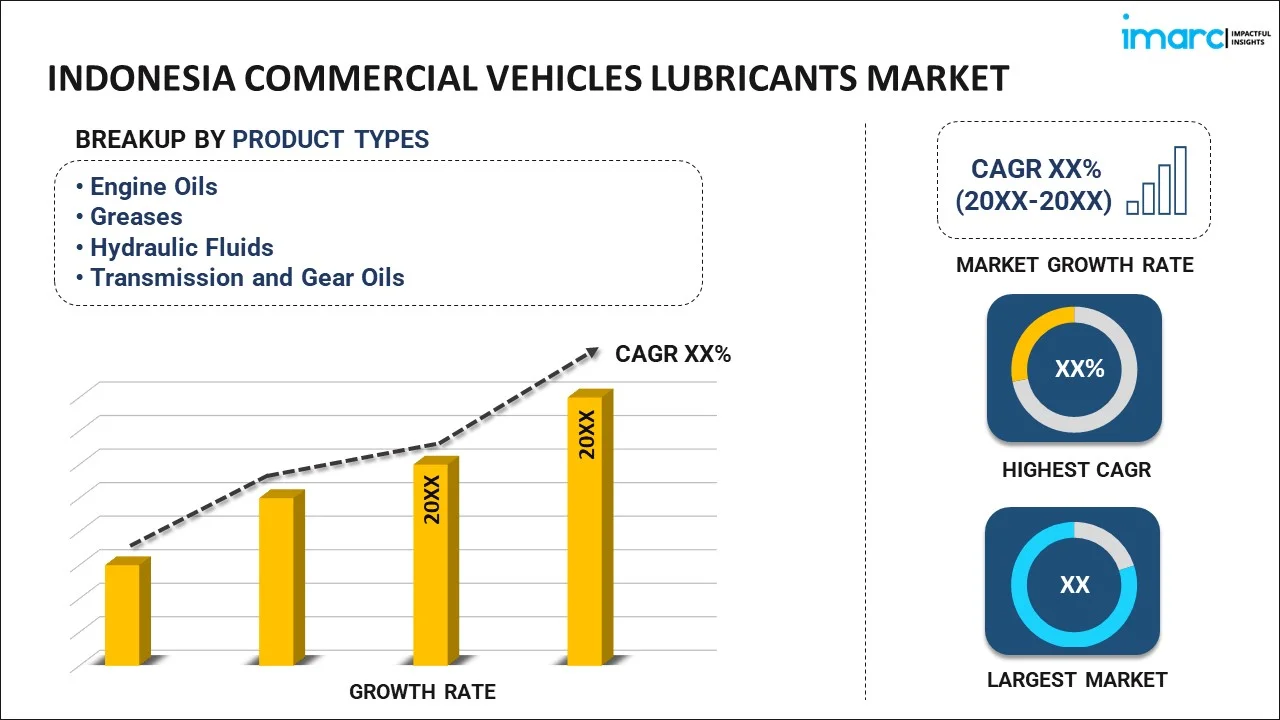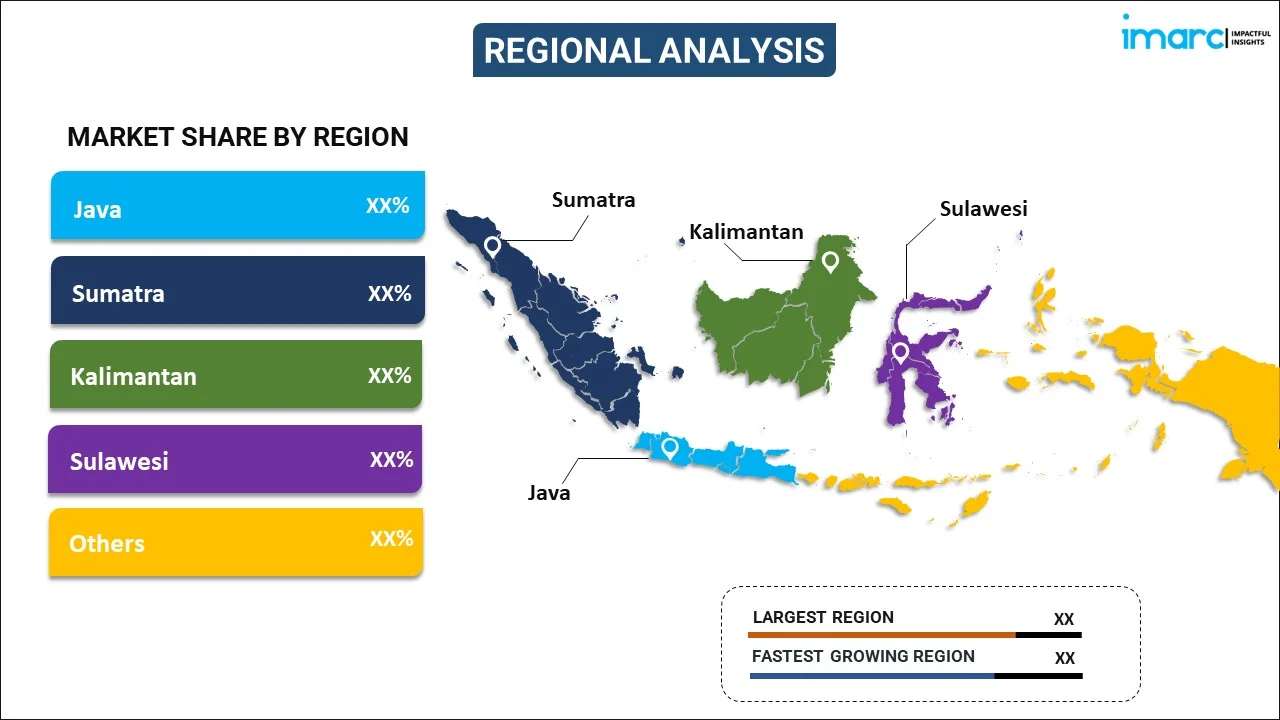
Indonesia Commercial Vehicles Lubricants Market Report by Product Type (Engine Oils, Greases, Hydraulic Fluids, Transmission and Gear Oils), and Region 2024-2032
Market Overview:
Indonesia commercial vehicles lubricants market size is projected to exhibit a growth rate (CAGR) of 3.82% during 2024-2032. The rising need for heavy-duty vehicles for transporting goods, increasing demand for bio-based lubricants, and continuous investments by various companies in research and development (R&D) activities to produce lubricants with enhanced performance characteristics represent some of the key factors driving the market.
|
Report Attribute
|
Key Statistics
|
|---|---|
|
Base Year
|
2023 |
|
Forecast Years
|
2024-2032 |
|
Historical Years
|
2018-2023
|
| Market Growth Rate (2024-2032) | 3.82% |
Commercial vehicle lubricants are specialized oils and fluids used in heavy-duty vehicles like trucks, buses, and vans to reduce friction between moving parts, improve performance, and extend the lifespan of the engine and other components. They are available in various formulations, such as engine oils, transmission fluids, gear oils, and hydraulic fluids. They can handle the elevated stress and temperature conditions inherent in commercial operations, thereby minimizing wear and tear on engine components. Besides this, as they contribute to reducing the carbon footprint of commercial vehicles, the demand for commercial vehicle lubricants is increasing across Indonesia.
Indonesia Commercial Vehicles Lubricants Market Trends:
Rapid urbanization and the expansion of logistics and transportation sectors represent one of the primary factors stimulating the market growth in Indonesia. Additionally, the expansion of automotive, machinery, and manufacturing plants in the country is driving the demand for lubricants. These sectors rely heavily on machinery and equipment that require effective lubrication for smooth operation. Along with this, the escalating demand for synthetic and semi-synthetic lubricants that are engineered to meet the rigorous needs of commercial applications and extended driving conditions typical in the diverse landscape of the country is driving the market. These advanced formulations result in longer engine life and lower maintenance costs, making them increasingly appealing to fleet operators. Apart from this, the rising shift toward bio-based lubricants, formulated to meet stricter environmental standards and offer better engine protection, is strengthening the growth of the market in the country. Furthermore, the regulatory bodies of the country are implementing stringent emission norms to encourage lubricant manufacturers to focus on eco-friendly solutions. These green lubricants meet performance metrics and reduce the carbon footprint and harmful emissions of commercial vehicles. Moreover, rising preferences of individuals for longer drain intervals, high fuel efficiency, and sustainability are strengthening the growth of the market in the country. In addition, fleet managers are favoring lubricants that offer extended service life and minimal engine wear, thereby reducing operational downtimes. Besides this, the implementation of telematics and Internet of Things (IoT) technologies is empowering fleet managers with real-time data about vehicle performance and lubricant conditions. The data-driven insights provided by these technologies are making it easier for fleet managers to make informed decisions about when to change lubricants, thereby optimizing operational efficiency and resource allocation. In addition, leading market players in Indonesia are continuously investing in research and development (R&D) activities to formulate lubricants that are more durable, corrosion-resistant, and environment friendly.
Indonesia Commercial Vehicles Lubricants Market Segmentation:
IMARC Group provides an analysis of the key trends in each segment of the market, along with forecasts at the country level for 2024-2032. Our report has categorized the market based on product type.
Product Type Insights:

- Engine Oils
- Greases
- Hydraulic Fluids
- Transmission and Gear Oils
The report has provided a detailed breakup and analysis of the market based on the product type. This includes engine oils, greases, hydraulic fluids, and transmission and gear oils.
Regional Insights:

- Java
- Sumatra
- Kalimantan
- Sulawesi
- Others
The report has also provided a comprehensive analysis of all the major regional markets, which include Java, Sumatra, Kalimantan, Sulawesi, and Others.
Competitive Landscape:
The market research report has also provided a comprehensive analysis of the competitive landscape in the market. Competitive analysis such as market structure, key player positioning, top winning strategies, competitive dashboard, and company evaluation quadrant has been covered in the report. Also, detailed profiles of all major companies have been provided.
Indonesia Commercial Vehicles Lubricants Market Report Coverage:
| Report Features | Details |
|---|---|
| Base Year of the Analysis | 2023 |
| Historical Period | 2018-2023 |
| Forecast Period | 2024-2032 |
| Units | US$ Million |
| Scope of the Report | Exploration of Historical Trends and Market Outlook, Industry Catalysts and Challenges, Segment-Wise Historical and Future Market Assessment:
|
| Product Types Covered | Engine Oils, Greases, Hydraulic Fluids, Transmission and Gear Oils |
| Regions Covered | Java, Sumatra, Kalimantan, Sulawesi, Others |
| Customization Scope | 10% Free Customization |
| Report Price and Purchase Option | Single User License: US$ 3699 Five User License: US$ 4699 Corporate License: US$ 5699 |
| Post-Sale Analyst Support | 10-12 Weeks |
| Delivery Format | PDF and Excel through Email (We can also provide the editable version of the report in PPT/Word format on special request) |
Key Questions Answered in This Report:
- How has the Indonesia commercial vehicles lubricants market performed so far and how will it perform in the coming years?
- What has been the impact of COVID-19 on the Indonesia commercial vehicles lubricants market?
- What is the breakup of the Indonesia commercial vehicles lubricants market on the basis of product type?
- What are the various stages in the value chain of the Indonesia commercial vehicles lubricants market?
- What are the key driving factors and challenges in the Indonesia commercial vehicles lubricants?
- What is the structure of the Indonesia commercial vehicles lubricants market and who are the key players?
- What is the degree of competition in the Indonesia commercial vehicles lubricants market?
Key Benefits for Stakeholders:
- IMARC’s industry report offers a comprehensive quantitative analysis of various market segments, historical and current market trends, market forecasts, and dynamics of the Indonesia commercial vehicles lubricants market from 2018-2032.
- The research report provides the latest information on the market drivers, challenges, and opportunities in the Indonesia commercial vehicles lubricants market.
- Porter's five forces analysis assist stakeholders in assessing the impact of new entrants, competitive rivalry, supplier power, buyer power, and the threat of substitution. It helps stakeholders to analyze the level of competition within the Indonesia commercial vehicles lubricants industry and its attractiveness.
- Competitive landscape allows stakeholders to understand their competitive environment and provides an insight into the current positions of key players in the market.
Need more help?
- Speak to our experienced analysts for insights on the current market scenarios.
- Include additional segments and countries to customize the report as per your requirement.
- Gain an unparalleled competitive advantage in your domain by understanding how to utilize the report and positively impacting your operations and revenue.
- For further assistance, please connect with our analysts.
 Inquire Before Buying
Inquire Before Buying
 Speak to an Analyst
Speak to an Analyst
 Request Brochure
Request Brochure
 Request Customization
Request Customization




.webp)




.webp)












